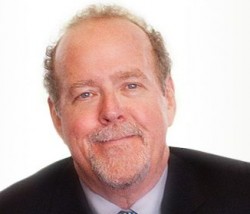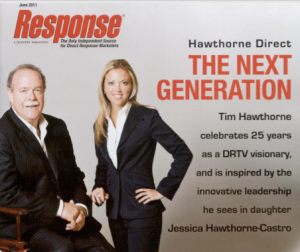While we all hunker down, work from home, and stream video content, I thought it would be a wonderful idea to talk to one of the original greats in long-form video advertising, Tim Hawthorne, founder of Hawthorne Advertising. On June 1, Tim will be bestowed a “Lifetime Achievement” honor by Marketing EDGE in New York as part of its EDGE Awards. Here, he shares valuable perspective on a video advertising career in an increasingly rich, ubiquitous medium for consumers, brands, and marketers.

A ‘Love Story’ for Film
Chet: Tim, first of all, congratulations! I’m so happy to see you recognized by Marketing EDGE – with its mission of marketing education and professional development, bringing the best and brightest into the marketing field. When you graduated from college – Harvard University no less, in 1973 (really, I mean, “Love Story“) – did you have any inkling that you would build a career of first in direct-response television (DRTV) and video advertising?
Tim: No, I had no idea in 1968 as I matriculated to Harvard that I would eventually become a pioneer of direct response television marketing. (First of all, yes, “Love Story” for sure. I was wandering through the Harvard Yard in the fall of 1969 when they were shooting exteriors. Not sure, but I might be one of those students hurriedly rushing to class in the background.)

It was turbulent times while I attended Harvard – 1968-1973. (I’m actually Class of ’68 but took a year off after my sophomore year to teach school in Ethiopia with the Harvard Africa Volunteer Project, so I graduated in ’73.) Initially, I intended to study chemistry, then switched to social psychology, influenced by the turbulent social times in the late 60s. But after getting my hands on a still camera in Ethiopia, I decided I’d take a still photography/documentary filmmaking course when I reentered Harvard in the fall of ’71. I was fascinated with the process of editing film, and then determined I’d pursue a career in filmmaking.
Searching for a job post-graduation in my hometown of Minneapolis, I was fortunate to be hired by the investigative documentary unit of the local CBS station, WCCO-TV. I worked there for almost five years, advancing from production assistant to editor to cinematographer, learning the craft of long-form storytelling. Our unit produced amazing documentaries that were often the No. 1 rated television programs in the Minneapolis/St. Paul market and won multiple awards, including the du Pont-Columbia and Peabody awards. I then became a producer/director/writer when I moved to the NBC affiliate in Philadelphia and eventually worked for a number of LA-based network primetime reality-based shows such as “Real People” and “That’s Incredible.”
Chet: Did you grow up having a love for industrial films of the 50s and 60s – which I think were a great precursor to the infomercial age and video advertising?
Tim: No, I didn’t have any particular love for industrial films (which in the 50s, 60s, and 70s were the height of boring and simplistic video communications!) It’s my background in documentaries – telling a long form story on people and subjects – that seemed a natural basis on which to pioneer telling long-form consumer product stories.
Like many consumers, I’ve never liked being “sold” especially when I’ve felt manipulated. And of course, short-form TV commercial brand selling is very much about manipulating emotions (via humor, poignancy, excitement) and associating strong positive images (sex, strength, beauty) with a product – a very subtle and often deceptive way of selling.
Infomercial or long-form advertising has always been based on factual selling – the exposition of features and benefits – of course, in as entertaining a way as possible. But at least the channel is up-front about its message: Here’s a product, here’s what it can do, and here are the benefits to you. This “truth in advertising” has always appealed to me. Producing documentaries is also about discovering the truth about a person, group, or issue.
In 1984, having moved from LA to Iowa for lifestyle reasons (wanting to raise our daughter Jessica in the Midwest where I grew up), I was open for new opportunities. A local real estate investment entrepreneur heard of my background and approached me about producing a long-form commercial. It would be an hour long … and a challenge. That was November 1984, one of the first infomercials on air. Within 12 months, the infomercial had grossed more than $60 million dollars and dominated the long-form air waves. Fairfield Television Enterprise was the company I formed to market the infomercial and over 18 months we revolutionized long-form TV direct response.
Chet: How did early success stories translate to business growth? Were there mentors you paid close attention to? (Alvin Eicoff comes to mind).
Tim: Eighteen months after launching Ed Beckley’s real estate investment infomercial, I became disillusioned with the way the company was moving forward. I resigned in April 1986 and took a couple of months off before starting Hawthorne Communications, later to become Hawthorne Direct, and then become Hawthorne Advertising. In late June 1986, I was a one-person company with the goal to persuade Fortune 500 companies to add long-form TV commercials to their marketing mix. We were the first infomercial ad agency in the world and I was confident that virtually all products had, somewhere at their hearts, a fascinating story we tell and hold viewers’ attention for 28 minutes and 30 seconds.
The agency had a singular focus: TV long-form advertising. There was no road map for the industry. We invented it as we went along. Certainly Al Eicoff was the reigning master of DRTV (and his book “Or Your Money Back” a short-form DRTV bible) but his company focused on short-form DRTV (2 minutes or less). So I and my growing team began to innovate, and I began to write about and present the long form story to marketing groups and corporations literally around the world. There was no road map; we were the trailblazers.
A Litany of Firsts and Video Advertising Innovations
Chet: Trailblazer indeed. What are some of the innovations you have brought to the field of DRTV, infomercials, and more recently digital video programming? How has digital disruption affected the traditional DRTV and broadcast channel, from a marketing perspective?
Tim: I’ve been called a “leading architect” of the DRTV industry by producing an impressive string of “firsts”:
- Co-founder and president of the first infomercial direct marketer to break the $50 million revenue per year mark, Fairfield Television Enterprises
- Founder and chairman of the first infomercial advertising agency, Hawthorne Communications
- Produced the first infomercial for: a Fortune 500 company – Time Life; a major music company – Time Life Music; a major credit card company – Discover Card; a major health insurance company – Blue Cross Blue Shield; and a retail driving campaign for a brand name product – Braun
- Infomercial Agency of Record for the first infomercial for: a major computer company – Apple Computers; and a major weight loss company – Weight Watchers
- Infomercial Agency of Record for the first “promo-mercial” – a half-hour promotion for a primetime TV series (NBC’s “JAG”)
- Published the industry’s first newsletter: “The 1-800 Report”
- Published the industry’s first hard-bound textbook on infomercials: “The Complete Guide to Infomercial Marketing”
- Created the first long-form TV media buying computer analysis system – “Time Track”
- Purchased the first long-term cable TV bulk media contract: Discover Network, for $50 per half hour, six hours per night
- Established the first infomercial agency/traditional agency alliance with Earl Palmer Brown
As for innovations to digital video, Hawthorne was one of the first agencies to actively use video promotion on websites (late 1990s) and we pioneered the “drive online direct sales” with short-form TV commercials, which were designed to motivate new visitors to our web-based clients.
Yes, the digital economy has significantly disrupted DRTV, as it has the television entertainment model as a whole. With a 35% drop in primetime adult (18-49) viewership from 2015-2019, the era of aggregating mass audiences on broadcast TV is long over.
A Family Affair – and an Investment in the Future
Chet: Was it a great leap – or expansion – from Fairfield, Iowa (hey, I’m from Nebraska) to Los Angeles? What brought Hawthorne Advertising to LA (and beyond)? Was there a talent pool you needed there?
Tim: From the beginning, Hawthorne was somewhat disadvantaged being a national advertising agency headquartered in a small Iowa town. We did have a small LA office (two staff) from the early 90s to keep in touch with our West Coast clients. But when Jessica (my daughter) came on board in March 2007, she brought an energy and vision to the company previously unknown.
Her goal was to build the LA office and lead the company into a digital future. And she has done that in spades, making LA our headquarters, while our Iowa office strongly administratively supports LA to this day. Our LA office certainly had access to talent we always struggled to persuade to move to Iowa, as you, being a Nebraskan, are probably aware of. It was a brilliant move by Jessica which has allowed the company to continue to thrive going into our 35th year.
Chet: Well now we know why Marketing EDGE named Jessica Hawthorne-Castro a 2015 Rising Stars honoree. (You must be very proud!)
Tim: Yes, I’m very proud of Jessica’s ownership and leadership of the company. And it wasn’t by design. Jessica was a thriving talent agent at Endeavor, one of the few women agents at that male-dominated business with six years’ tenure. But she recognized that industry was missing certain business and spiritual values important to her. In February 2007, I coincidentally asked her if she had time to monitor a commercial talent audition in LA that we needed someone to attend. She did it, enjoyed it, and said she would be open to coming on board at Hawthorne. Over the next five years she soaked up the business, brought much-needed youthfulness to our efforts, advanced from client service associate to CEO, and built our LA office to 50-plus employees, while transforming the agency to a digital foundation.
Chet: As an author of several business books on DRTV and infomercial formats, and likely a bevy of company alumni in the field today, you’ve contributed so much to the professional development of data-driven marketers, marketing measurement, attribution and the like. What part of giving back to the field do you find most gratifying? Is there a particular “lifetime” achievement you’re most proud of?

Tim: My greatest achievement? Creating a company that has endured for 35 years and allowed hundreds of staff to learn, thrive, and grow in marketing knowledge and experience, while realizing greater personal achievement and confidence. We created a company that was a home for our staff to do great work amid friendship and respect. Undoubtedly my greatest achievement, far beyond any creative work for a client.
Thank you Tim – and we’re so happy to celebrate your contributions at the EDGE Awards come June 1. And much more video success ahead!





